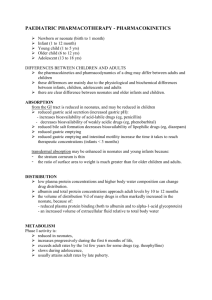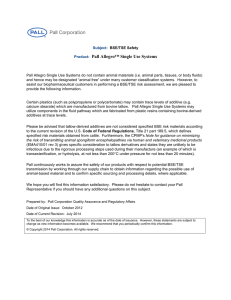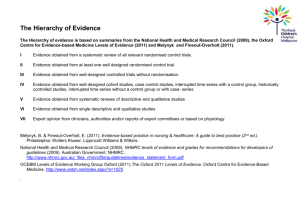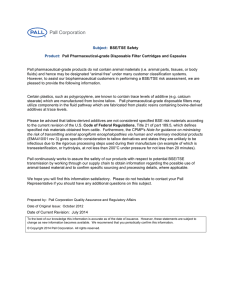It is possible to protect infants against the
advertisement
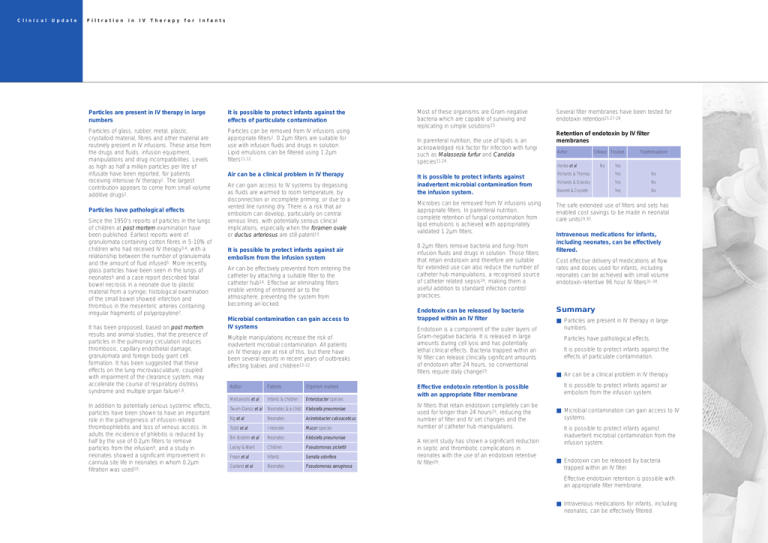
C l i n i c a l U p d a t e F i l t r a t i o n i n I V T h e r a p y f o r I n f a n t s Particles are present in IV therapy in large numbers It is possible to protect infants against the effects of particulate contamination Particles of glass, rubber, metal, plastic, crystalloid material, fibres and other material are routinely present in IV infusions. These arise from the drugs and fluids, infusion equipment, manipulations and drug incompatibilities. Levels as high as half a million particles per litre of infusate have been reported, for patients receiving intensive IV therapy1. The largest contribution appears to come from small volume additive drugs2. Particles can be removed from IV infusions using appropriate filters2. 0.2µm filters are suitable for use with infusion fluids and drugs in solution. Lipid emulsions can be filtered using 1.2µm filters11,12. Particles have pathological effects Since the 1950's reports of particles in the lungs of children at post mortem examination have been published. Earliest reports were of granulomata containing cotton fibres in 5-10% of children who had received IV therapy3,4, with a relationship between the number of granulomata and the amount of fluid infused5. More recently, glass particles have been seen in the lungs of neonates6 and a case report described fatal bowel necrosis in a neonate due to plastic material from a syringe; histological examination of the small bowel showed infarction and thrombus in the mesenteric arteries containing irregular fragments of polypropylene7. It has been proposed, based on post mortem results and animal studies, that the presence of particles in the pulmonary circulation induces thrombosis, capillary endothelial damage, granulomata and foreign body giant cell formation. It has been suggested that these effects on the lung microvasculature, coupled with impairment of the clearance system, may accelerate the course of respiratory distress syndrome and multiple organ failure1,8. In addition to potentially serious systemic effects, particles have been shown to have an important role in the pathogenesis of infusion-related thrombophlebitis and loss of venous access. In adults the incidence of phlebitis is reduced by half by the use of 0.2µm filters to remove particles from the infusion9, and a study in neonates showed a significant improvement in cannula site life in neonates in whom 0.2µm filtration was used10. Air can be a clinical problem in IV therapy Air can gain access to IV systems by degassing as fluids are warmed to room temperature, by disconnection or incomplete priming, or due to a vented line running dry. There is a risk that air embolism can develop, particularly on central venous lines, with potentially serious clinical implications, especially when the foramen ovale or ductus arteriosus are still patent13. It is possible to protect infants against air embolism from the infusion system Air can be effectively prevented from entering the catheter by attaching a suitable filter to the catheter hub14. Effective air eliminating filters enable venting of entrained air to the atmosphere, preventing the system from becoming air-locked. Microbial contamination can gain access to IV systems Multiple manipulations increase the risk of inadvertent microbial contamination. All patients on IV therapy are at risk of this, but there have been several reports in recent years of outbreaks affecting babies and children15-22. Author Patients Organism involved Matsaniotis et al Infants & children Enterobacter species Twum-Danso et al Neonates & a child Klebsiella pneumoniae Ng et al Neonates Acinetobacter calcoaceticus Todd et al I neonate Mucor species Bin Ibrahim et al Neonates Klebsiella pneumoniae Lacey & Want Children Pseudomonas pickettii Frean et al Infants Serratia odorifera Garland et al Neonates Pseudomonas aeruginosa Most of these organisms are Gram-negative bacteria which are capable of surviving and replicating in simple solutions23. In parenteral nutrition, the use of lipids is an acknowledged risk factor for infection with fungi such as Malassezia furfur and Candida species11,24. It is possible to protect infants against inadvertent microbial contamination from the infusion system. Microbes can be removed from IV infusions using appropriate filters. In parenteral nutrition, complete retention of fungal contamination from lipid emulsions is achieved with appropriately validated 1.2µm filters. 0.2µm filters remove bacteria and fungi from infusion fluids and drugs in solution. Those filters that retain endotoxin and therefore are suitable for extended use can also reduce the number of catheter hub manipulations, a recognised source of catheter related sepsis24, making them a useful addition to standard infection control practices. Endotoxin can be released by bacteria trapped within an IV filter Endotoxin is a component of the outer layers of Gram-negative bacteria. It is released in large amounts during cell lysis and has potentially lethal clinical effects. Bacteria trapped within an IV filter can release clinically significant amounts of endotoxin after 24 hours, so conventional filters require daily change23. Effective endotoxin retention is possible with an appropriate filter membrane IV filters that retain endotoxin completely can be used for longer than 24 hours25, reducing the number of filter and IV set changes and the number of catheter hub manipulations. A recent study has shown a significant reduction in septic and thrombotic complications in neonates with the use of an endotoxin retentive IV filter26. Several filter membranes have been tested for endotoxin retention25,27-28. Retention of endotoxin by IV filter membranes Author Cellulose Posidyne Horibe et al No Polyethersulphone Yes Richards & Thomas Yes No Richards & Grassby Yes No Barnett & Cosslett Yes No The safe extended use of filters and sets has enabled cost savings to be made in neonatal care units29,30. Intravenous medications for infants, including neonates, can be effectively filtered. Cost effective delivery of medications at flow rates and doses used for infants, including neonates can be achieved with small volume endotoxin-retentive 96 hour IV filters31-34. Summary ■ Particles are present in IV therapy in large numbers. Particles have pathological effects. It is possible to protect infants against the effects of particulate contamination. ■ Air can be a clinical problem in IV therapy. It is possible to protect infants against air embolism from the infusion system. ■ Microbial contamination can gain access to IV systems. It is possible to protect infants against inadvertent microbial contamination from the infusion system. ■ Endotoxin can be released by bacteria trapped within an IV filter. Effective endotoxin retention is possible with an appropriate filter membrane. ■ Intravenous medications for infants, including neonates, can be effectively filtered. ELD132B U p d a t e F i l t r a t i o n i n I V T h e r a p y f o r I n f a n t s Reference 1. Kirkpatrick CJ, Krankenhauspharmazie 1988;9:487-490. 19. Bin Ibrahim A & Ghaznawi HI, 2nd Int Conf Hosp Infect Soc, London, 1992. 2. Backhouse CM et al, J Pharm Pharmacol 1987;39:241-245. 20. Lacey S & Want SV, J Hosp Infect 1991;17:45-51. 3. Brunning EF, Arch Path Anat 1955;327:460-479. 4. Sarrut S & Nezelof C, Presse Medicale 1960;68:375-377. 23. Holmes CJ et al, J Clin Micro 1980;12:725-731.. 5. Jacques WF & Mariscal GG, Bull Intern Assoc Med Museums 1951;32:63-72. 24. Lee K, 25th Conf Infect Contr Nurse Assoc, Lancaster, 1994. 6. Puntis JWL et al, Arch Dis Child 1992;67: 1475-1477. 25. Richards C & Grassby PF, J Clin Pharm Therap 1994;19:199-202. 7. Cant AJ et al, BMJ 1988;296:968-969. 26. van Lingen RA et al. Journal of Clinical Microbiology and Infection 1997: 3; 122. 8. Walpot H et al, Anaesthesist 1989;38:544-548. 9. Falchuk KH et al, NEJM 1985;312:78-82. 21. Frean JA et al, J Hosp Infect 1994;27:263-273. 11. Lewis JS, Hosp Pharm 1993;28:656-658,697. 12. Pall Technical Bulletin 2001. 13. Willis J et al, Pediatrics 1981;67:472-473. 17. Ng PC et al, J Hosp Infect 1989;14:363-368. 18. Todd N et al, J Hosp Infect 1990;15:295-297. Blood Group Europa House, Havant Street Portsmouth PO1 3PD, England +44 (0)2392 302366 +44 (0)2392 302505 Biosvc@Pall.com telephone fax E-mail 29. Bennion D & Martin K, Paediatric Nursing, June1991. 30. Kunac DL et al. Australian J hospital Pharmacy 1999;29:321-327 14. Coppa GF et al, J Parent Ent Nut 1980:5:166-168. 16. Twum-Danso K et al, J Hosp Infect 1989; 14:271-274. 27. Horibe K et al, J Parent Ent Nut 1990:14:56-59. 28. Richards C & Thomas P, J Clin Pharm Therap 1990;15:53-58. 10. Thomas PH, Proc Guild Hosp Pharm 1989; 26:3-10. 15. Matsaniotis NS et al, Infection Control 1984; 5:471-474. 22. Garland SM et al, J Hosp Infect 1996;33:145-151. 31. Freeman A et al. NZ Hospital Pharmacists' Association 1997. 32. Birnie L et al. NZ Hospital Pharmacists' Association 1998. 33. Birnie L et al. NZ Hospital Pharmacists' Association 1998. 34. Wilkie A et al. NZ Hospital Pharmacists'Association 1998. Visit us on the web at www.pall.com/medical International Offices Pall Corporation has offices and plants throughout the world in locations such as: Argentina, Australia, Austria, Belgium, Brazil, Canada, China, France, Germany, Hong Kong, India, Indonesia, Ireland, Italy, Japan, Korea, Malaysia, Mexico, the Netherlands, New Zealand, Norway, Poland, Puerto Rico, Russia, Singapore, South Africa, Spain, Sweden, Switzerland, Taiwan, Thailand, the United Kingdom, the United States and Venezuela. Distributors in all major industrial areas of the world. The information provided in this literature was reviewed for accuracy at the time of publication. Product data may be subject to change without notice. For current information consult your local Pall distributor or contact Pall directly. Part numbers quoted above are protected by the Copyright of Pall Europe Ltd. and Pall are trade marks of Pall Corporation. Filtration. Separation. Solution. is a service mark of Pall Corporation. ©1999, 2001 Pall Europe Limited. Printed in England. PMED/2M/DAP/05/2001 clinical update C l i n i c a l F i l t r a t i o n I V f o r T h e r a p y I n f a n t s i n
